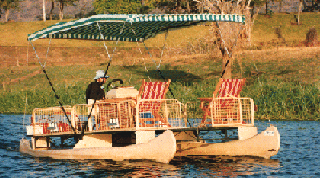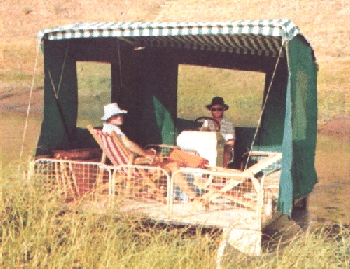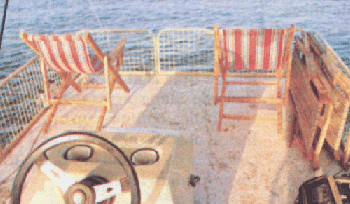FIBRECRAFT/CHASE MARINE
MINI
SKIMMER
Specifications | Boat
report | Results
Specifications
Length
18' 0"
5.49m
Width
12' 0"
3.65m
Weight - Boat
485 lb
220 kg
Recommended Horsepower
3.5 to 25 hp
Standard Equipment
-
Railings
-
Sun canopy
-
Transom bracket
Optional Extras
-
Console and seat
-
Trailer
-
Tent sides for canopy
back to top
Boat
Report
(by kind permission of the African
Fisherman September 1992)
Our craft for this test is more raft than boat. A unique combination
of sealed canoe pods and steel superstructure designed as a versatile craft,
that can be used in varied conditions and for many purposes. Based on two
eighteen foot Canadian canoes, the Skimmer has a deck area measuring 3.65
m (12 foot) by 2.43 m (8 foot) offering a platform no conventional boat
can match.
Because of the nature of this craft, rpm to speed ratios would serve
little purpose. Instead we tested the skimmer with three different motors,
a 5 hp, 15 hp and a 30 hp through varied conditions. Previous trials carried
out by Ivor Kesson over an accurately measured course, showed that the
Skimmer fitted with a 3.5hp with 4 people aboard attained 12 km/h. With
a 15hp Ivor was able to pull his young son on skis behind the craft. Our
tests showed that a 15hp would be the optimum motor for this craft.
Construction
The two Canadian canoes are constructed using 450 gram chopped strand
mat and one layer 900 gram woven roving hand laid over the gel coat. Four
additional strip layers of 450 gram c.s.m. are laid into the keel to protect
against wear. Four sealed compartments each with inspection fittings are
built into the pods using 19 mm Marine Play bulk heads, these act as flotation
chambers. The floats are connected by three transverse lightweight steel
lattice beams which are primed and sprayed with enamel, which when combined
with the longitudinal floats give excellent torsional strength eliminating
twist. The deck is constructed from 13 mm Marine Ply covered with fibreglass
and finished with a non skid polyester finish. Enclosing railings are made
from epoxy coated mild steel and incorporate three gates. Tests using the
different motors with a load of two people, 40 litres fuel, a battery and
deck chairs etc., showed the following.
30 hp Yamaha
The Skimmer tested was fitted with this motor by its owner for use
on the Zambezi around Msuna. Steered with a Ride guide steering from the
centre console positioned toward the stern, I had comfortable easy control
of the craft at all times. Later tests highlighted the limited turning
circle afforded by the Rideguide system.
In my opinion the raft was overpowered by the 30 hp. With three
people aboard, the Skimmer seemed to reach an optimum speed of approximately
40 km/h which was too fast for the hydrodynamic design of the canoe pontoons.
As the Skimmer does not plane as such, the stern dug in under the force
of the thrust creating extra drag, while the ride becoming noticeably uncomfortable
with considerable water being thrown up by the bows. Although one would
obviously not drive the boat at full power because of this, the weight
factor of this motor is important. The bigger the motor the less level
the attitude. The use of a Doelfin helped lift the stern marginally, but
made little overall difference.
15 hp Mariner
As this motor was a tiller control we disconnected the Rideguide
and piloted from the stern. The 15 hp seemed ideal, providing power to
push the craft along under normal load, whilst still having a bit extra
torque to deal with increased loads. The weight of the smaller motor had
little effect on the horizontal attitude of the Skimmer, although the extra
weight of the pilot now seated on the stern did. In the case of tiller
control motors there would be little use for the console, as it inhibits
forward vision. This in fact was one disadvantage to the smaller tiller
control motors. Sitting low at the stern restricted ones all round vision,
and in waters with numerous underwater obstacles, one would be hard pressed
to pilot as well as keep an effective lookout for those lurking rocks etc.
5 hp Mariner
As the Skimmer is designed for short sedate hops from main base
camp or houseboat, I would personally select this smaller less expensive
motor. The added advantages of the five horsepower is that it is considerably
quieter, lighter and more economic than its bigger counterparts and still
gets the Skimmer buzzing along at between 15 to 20 km/h, which is not much
different to a 14 foot tender with the equivalent power. A big plus of
the smaller tiller control motors is their manoeuvrability. I was able
to execute tighter turns and even push the raft sideways as well as using
the motor as brakes by turning it almost 180 degrees. This made docking
under windy conditions considerably easier as the bulk of the raft acts
as a sail in stiff breeze.
After spending a couple of days on the Skimmer, my imagination began
to run away with me. The simplicity of the standard design invites customization,
and the possibilities are endless.
 During the
test Ivor fitted canvas sides to the canopy that totally enclosed the Skimmer
turning it into a mini-houseboat. With the addition of bench type seating
incorporating storage, overnight excursions would be comfortable, stowing
the canvas sides during the day. In fact one of the recommended uses of
the Skimmer, suggests a houseboat tender that can double as staff quarters,
or alternatively, it could be used to sleep extra children, etc. During
the day the Skimmer would provide the ideal fishing or game viewing platform
able to accommodate up to nine people. Capacity one would find hard to
match with conventional tenders.
During the
test Ivor fitted canvas sides to the canopy that totally enclosed the Skimmer
turning it into a mini-houseboat. With the addition of bench type seating
incorporating storage, overnight excursions would be comfortable, stowing
the canvas sides during the day. In fact one of the recommended uses of
the Skimmer, suggests a houseboat tender that can double as staff quarters,
or alternatively, it could be used to sleep extra children, etc. During
the day the Skimmer would provide the ideal fishing or game viewing platform
able to accommodate up to nine people. Capacity one would find hard to
match with conventional tenders.  Because
of its lightweight construction and relatively drag free design, the skimmer
would tow comfortably behind a bigger vessel. The Skimmer is used commercially
above the falls as a "booze cruise" and is registered to carry nine people
including the pilot.
Because
of its lightweight construction and relatively drag free design, the skimmer
would tow comfortably behind a bigger vessel. The Skimmer is used commercially
above the falls as a "booze cruise" and is registered to carry nine people
including the pilot.
The Skimmer would fit equally well on to many of our inland waters
as a weekend getaway. Correctly fitted out, the Skimmer would provide an
ideal family craft, giving plenty of space for children to occupy themselves
when they become bored with fishing (as the little darlings do). Fibrecraft
also provides a loan trailer for rafts that are going to be stationed on
the water, eliminating this cost from the purchase price.
I found it hard to criticize the Skimmer as it is unique in its design
and application. There are few moving or corrodable fittings to be exposed
to the elements. I would be hesitant to take the craft out in really rough
water in spite of the "wet deck" design. Although it is not possible to
capsize the raft, the combination of overloading, rough water and an incompetent
pilot could spell disaster. This, however is true of any vessel !! A compromise
I would be willing to make with the Skimmer would be to substitute all
steel superstructure and railings etc., for aluminium., as I feel that
the more resistant aluminium would better serve the purpose of a craft
that is destined to serve most of its life in the water. This would
obviously increase the cost considerably and defeat one of the Skimmers
attributes, that of being an inexpensive package.
back to top
Test
Results
|
1
Poor
|
2
Poor
|
3
Ave
|
4
Ave
|
5
Ave
|
6
Good
|
7
Good
|
8
Good
|
9
Excel
|
10
Excel
|
| Trailer Construction |
. |
. |
. |
. |
. |
. |
 |
. |
. |
. |
| Launching |
. |
. |
. |
. |
. |
. |
 |
. |
. |
. |
| Retrieving |
. |
. |
. |
. |
. |
. |
 |
. |
. |
. |
| Hull moulding |
. |
. |
. |
. |
. |
. |
. |
. |
 |
. |
| Deck moulding |
. |
. |
. |
. |
. |
. |
. |
 |
. |
. |
| Hatches and Stowage (not Applicable) |
. |
. |
. |
. |
. |
. |
. |
. |
. |
. |
| Spray Coat |
. |
. |
. |
. |
. |
. |
 |
. |
. |
. |
| Gel coat |
. |
. |
. |
. |
. |
. |
. |
 |
. |
. |
| Upholstery |
. |
. |
. |
. |
. |
 |
. |
. |
. |
. |
| Steering , Accessory and wiring installation |
. |
. |
. |
. |
 |
. |
. |
. |
. |
. |
| Motor Installation |
. |
. |
. |
. |
. |
 |
. |
. |
. |
. |
| Overall presentation |
. |
. |
. |
. |
. |
. |
. |
 |
. |
. |
| Fittings installation |
. |
. |
. |
. |
. |
. |
 |
. |
. |
. |
| Fishability - Kariba |
. |
. |
. |
. |
. |
. |
. |
. |
. |
 |
|
- Inland Dam |
. |
. |
. |
. |
. |
. |
. |
. |
 |
. |
| Stowage |
. |
. |
 |
. |
. |
. |
. |
. |
. |
. |
| Stability - Maximum speed |
. |
. |
. |
. |
. |
. |
. |
 |
. |
. |
|
- at rest |
. |
. |
. |
. |
. |
. |
. |
. |
 |
. |
back to top
Back to Index
 During the
test Ivor fitted canvas sides to the canopy that totally enclosed the Skimmer
turning it into a mini-houseboat. With the addition of bench type seating
incorporating storage, overnight excursions would be comfortable, stowing
the canvas sides during the day. In fact one of the recommended uses of
the Skimmer, suggests a houseboat tender that can double as staff quarters,
or alternatively, it could be used to sleep extra children, etc. During
the day the Skimmer would provide the ideal fishing or game viewing platform
able to accommodate up to nine people. Capacity one would find hard to
match with conventional tenders.
During the
test Ivor fitted canvas sides to the canopy that totally enclosed the Skimmer
turning it into a mini-houseboat. With the addition of bench type seating
incorporating storage, overnight excursions would be comfortable, stowing
the canvas sides during the day. In fact one of the recommended uses of
the Skimmer, suggests a houseboat tender that can double as staff quarters,
or alternatively, it could be used to sleep extra children, etc. During
the day the Skimmer would provide the ideal fishing or game viewing platform
able to accommodate up to nine people. Capacity one would find hard to
match with conventional tenders.  Because
of its lightweight construction and relatively drag free design, the skimmer
would tow comfortably behind a bigger vessel. The Skimmer is used commercially
above the falls as a "booze cruise" and is registered to carry nine people
including the pilot.
Because
of its lightweight construction and relatively drag free design, the skimmer
would tow comfortably behind a bigger vessel. The Skimmer is used commercially
above the falls as a "booze cruise" and is registered to carry nine people
including the pilot.
